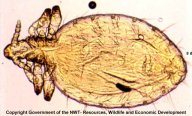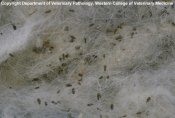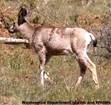|
|
| |
| Causative Agent |
-
Lice are small, flattened, wingless insects that are external parasites
of mammals and birds.
-
Lice are of two general types:
-
those that chew on fur, feathers and skin debris;
-
those that suck on blood.
|
| Images |
|
Click on
images to enlarge. |
 |
 |
 |
|
Photomicrograph of a chewing
louse. |
Lice within the fur of an
Arctic fox. |
Mule deer from Washington
state showing hair loss due to infestation with exotic lice. |
|
| Distribution |
|
Geographic: |
-
Found throughout the world.
-
Recently, cases have been reported of deer (Cervidae)
in the western United States and British Columbia
experiencing mild to severe hair loss due to infestations
with
exotic louse species brought to North America on non-native
introduced or exotic species of deer.
|
|
Seasonality: |
-
Lice populations undergo seasonal fluctuations that vary according to the
biology of the louse and affected host.
-
Found at higher numbers on affected animals in winter and early spring,
and are generally absent or extremely rare in summer and
autumn.
|
|
| Hosts, Transmission and Life
Cycle |
| Hosts: |
-
Birds and mammals.
-
Chewing lice are more often found on birds.
-
Sucking lice are exclusively found on mammals.
|
|
Transmission and Life Cycle: |
-
Lice vary from 0.3 to 10 mm long; chewing lice have a head that is
broader than the rest of the body while the head of sucking
lice is narrower than the rest of the body.
-
The entire life cycle of lice occurs on the host.
-
Lice lay eggs directly onto fur or feathers.
-
Transfer of lice between hosts occurs from physical contact.
-
Lice are very well adapted to a particular host
species and even to specific
areas on a host’s body; lice will not survive on other host
species.
-
Lice may serve as
vectors for other wildlife diseases
such as
Lyme disease,
brucellosis, hemobartonella,
ringworm,
salmonellosis and certain
tapeworms.
-
A generation of lice usually
lasts 45 days.
|
|
| Signs and Symptoms |
-
Small infestations of lice are commonplace on animals, and do not often
cause harm to the host.
-
Large numbers of lice may be found on older or young animals, animals in
poor condition, those suffering from a concurrent
illness, or those that are inefficient at grooming.
-
Lice leave the host 1-2 days following death of the host.
-
Animals may become immune to the effects of lice infestation resulting in
reduced survival of eggs, fewer eggs being produced, and a reduction
in feeding on host tissues.
-
Lice may cause the following in animals:
-
anemia;
-
itching;
-
inflammation
of
the skin;
-
skin
sensitivity;
-
allergic reactions;
-
intense grooming;
-
fur
mats;
-
loss
of hair;
-
secondary infections at the location of bites;
-
reduced survival in winter due to hair loss.
-
Death may result from heavy infestations in young animals or those
in poor condition from other disease conditions.
|
| Meat Edible? |
-
Meat quality is not affected by lice infestation.
|
| Human Health Concerns and
Risk Reduction |
-
Rubber gloves and protective clothing should be worn when handling
wildlife with skin conditions.
-
Although lice from animals cannot be transferred to humans, lice may
initially crawl onto humans when infected animals are handled. This
may cause a minor irritation, but the lice do not remain for long.
|
| Samples for Diagnosis |
-
Collection of a whole louse placed in 70% ethanol is sufficient for
identification.
|
| Similar Diseases |
-
Ticks
and
mites are
also external parasites but are very different in appearance.
|
| Further Reading |
|
|
|
|


